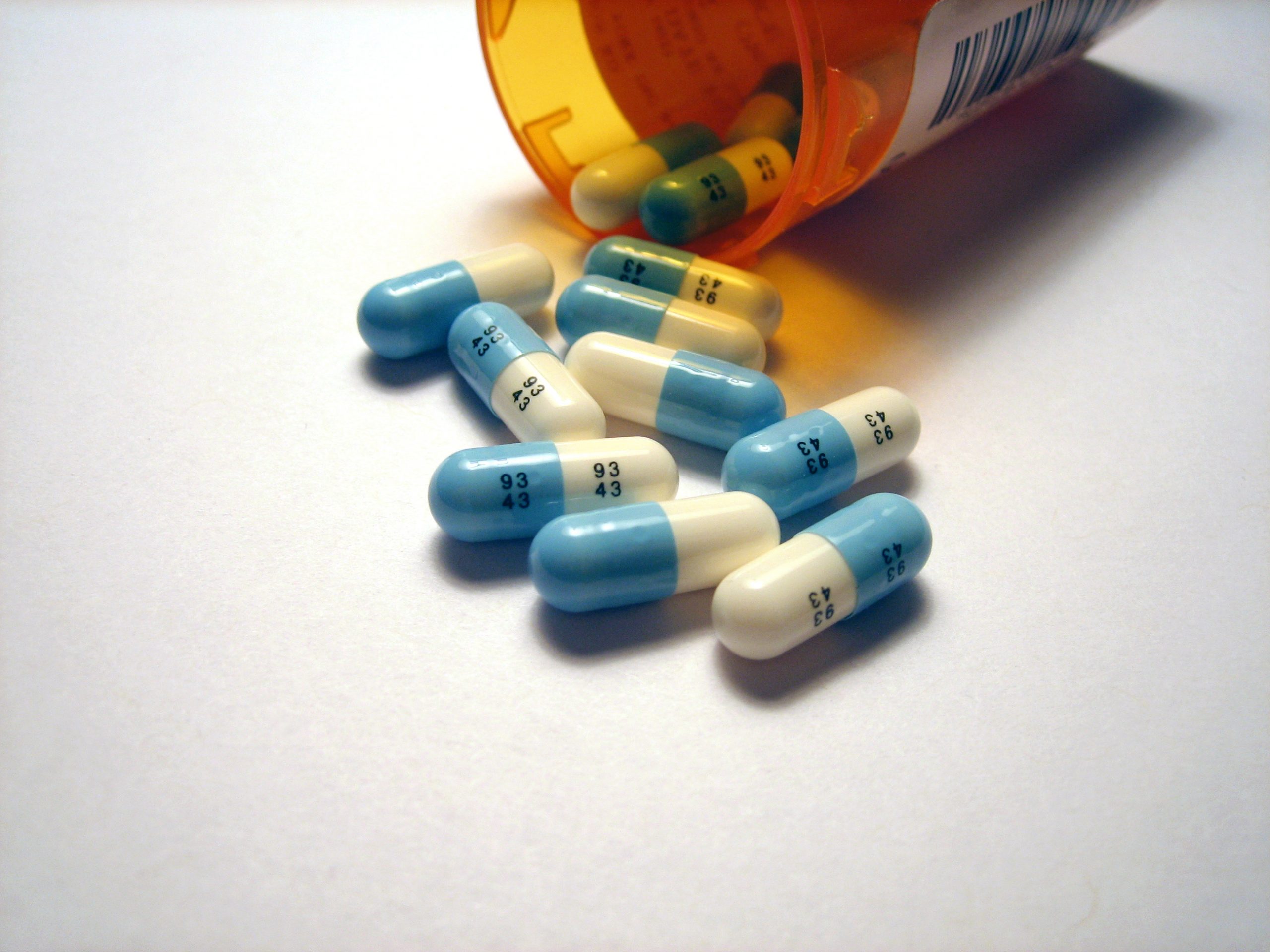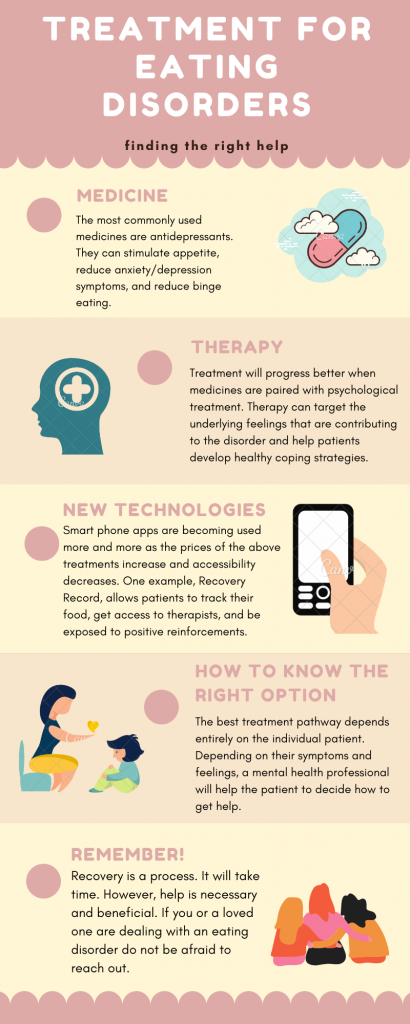13 Treatment for Eating Disorders
Lauren Gohs
Diagnosis
In the United States today, over 30 million people are suffering with an eating disorder. Anorexia nervosa, marked by a restriction of food intake, and bulimia nervosa, marked by patterns of eating a lot and then actions to make up for that, are some of the more dangerous ones. In fact, “Every 62 minutes at least one person dies as a direct result from an eating disorder” (ANAD, 2020). Anyone with an eating disorder should seek professional treatment. There are a wide range of options available. This range can go from simply attending therapy sessions to living in a treatment facility. The exact type of treatment that will be the most beneficial for a specific person depends on many different factors. Diagnosis by a mental health professional is the first step. From there, a mixture of medications, therapy, and nutritional counseling are often used.
Medicinal Treatments

For any kind of eating disorder the first kind of treatment is to get to eating food in a healthy pattern. But, pharmaceutical medicines can help to make recovery easier. Medications for eating disorders are more helpful in binge eating or bulimia disorders than the restrictive ones. The most common medicines used as treatment are antidepressants. Antidepressants are able to reduce the physical symptoms that go along with eating disorders while also dealing with the depression and anxiety symptoms. They can help to regulate mood and to reduce the compulsive behaviors that go along with binge eating. The antidepressants Fluoxetine and Trazodone, specifically, were found to be useful treatment options. Shapiro et al. (2007) found that “Trazodone led to significantly greater decreases in the frequency of binge eating and vomiting and in fear of eating” (p. 325). This change is more often seen in outpatient settings. However, even with medications people will still experience times of disordered eating habits. Medications are not a cure all. The short term effectiveness of this kind of treatment makes it important that medications are paired with therapy.
Psychological Treatments
Treatment for an eating disorder depends on the individual person and what will work best for them. A mental health professional is often the person who will decide what that treatment will look like. With any kind of psychological treatments, the therapist will work to normalize eating, help develop coping strategies, and to discuss one’s feelings. The most popular and effective form of treatment is cognitive behavioral therapy (CBT). CBT targets the thoughts and behaviors that go along with an eating disorder by first changing the behavior and then changing the way a person thinks about it. For example, an anorexic patient would be encouraged to start eating a full three meals a day. The therapist would then talk to the patient about how they are feeling after doing that. CBT is discussed in more detail in the following chapter.
Family-based therapy is another successful form of treatment. Family members will help their loved one to develop a healthy eating pattern and weight. This form of therapy shows the importance of having a supportive, but not overbearing family to make a lasting recovery. But, as with medicinal treatments, periods of disordered eating and unhealthy thoughts will still occur. Psychological treatments use this information to teach patients to deal with their stress and encourage positive thoughts.
For more information on each of the therapy options: https://www.mayoclinic.org/diseases-conditions/eating-disorders/in-depth/eating-disorder-treatment/art-20046234
Emerging Forms of Treatment
The forms of treatment mentioned above can be extremely costly. Hospital or rehabilitation center stays can even add up to thousands of dollars a day. Luckily, new styles and forms of treatment are being investigated constantly. They could lead to more effective, accessible, or affordable treatment options. One example with the potential to have a large impact is the Recovery Record app. Through this app, patients can get elements of CBT, plan meals, have positive reinforcements, and have the option to speak to a clinician. A study based on this popular app showed that it is highly accepted and enjoyed. “Results suggest that using the app as a customized aftercare tool can help further reduce ED symptoms after discharge from an inpatient treatment” (Neumayr et al., 2019, p.1200). But, this form of treatment is not yet fully functional. Studies and inventions show promise for coming up with forms of treatment that will work better in a modernizing society.
A video demonstration on how to use the app: https://www.youtube.com/watch?v=0GiTHaMJ2sE
Summary
When seeking treatment oneself or for a loved one remember to be patient. There are many factors leading to the eating disorder beyond just the food itself. Through support and treatment, recovery is very much possible. But, it will not happen overnight. As with any mental disorder, the symptoms and feelings can go on for months or even years. Finding the right kind of treatment based on a person’s unique needs is crucial. For a review of treatment options, please refer to the infographic below.

Review Questions
1. Who most often decides what kind of therapy a patient with an eating disorder will receive?
a. The patient
b. Family members
c. Mental health professional
d. Medical doctor
2. Medicinal treatments are the most effective for bulimia/binge eating disorders?
a. True
b. False
3. What is the most useful form of psychological treatment for eating disorders?
a. Cognitive behavioral therapy
b. Family-based therapy
c. Dialectical behavioral therapy
References
Fairburn, C.G. (2008). Cognitive behavior therapy and eating disorders. [eBook edition]. The Guilford Press. https://books.google.com/books?hl=en&lr=&id=KRvAlB3l8-MC&oi=fnd&pg=PA3&dq=eating+disorders&ots=70CyO9HxZ7&sig=KYQtH3GbI6tCplFlhXSw230-JGU#v=onepage&q=eating%20disorders&f=false
Mayo Clinic. (n.d.). Bulimia nervosa. https://www.mayoclinic.org/diseases-conditions/bulimia/diagnosis-treatment/drc-20353621
National Association of Anorexia Nervosa and Associated Disorders. (n.d.). How to Help a Loved One. https://anad.org/education-and-awareness/about-eating-disorders/how-to-help-a-loved-one/
National Association of Anorexia Nervosa and Associated Disorders. (2020). Eating Disorder Statistics. https://anad.org/education-and-awareness/about-eating-disorders/eating-disorders-statistics/
NEDA. (n.d.). Treatment. https://www.nationaleatingdisorders.org/treatment
Neumayr, C., Voderholzer, U., Tregarthen, J., & Schlegl, S. (2019). Improving aftercare with technology for anorexia nervosa after intensive inpatient treatment: A pilot randomized controlled trial with a therapist‐guided smartphone app. International Journal of Eating Disorders, 52(10), 1191–1201. https://doi-org.libproxy.clemson.edu/10.1002/eat.23152
Papadopoulos, F.C., Ekbom, A., Brandt, L., & Ekselius, L. (2009). Excess mortality, causes of death and prognostic factors in anorexia nervosa. The British Journal of Psychiatry, 194(1), 10-17. https://doi.org/10.1192/bjp.bp.108.054742
Shapiro, J., Berkman, N., Brownley, K., Sedway, J., Lohr, K., & Bulik, C. (2007). Bulimia nervosa treatment: a systematic review of randomized controlled trials. International Journal of Eating Disorders, 40 (4), 321-336. https://doi.org/10.1002/eat.20372
Varco, T. (2006). Prozac pills [Photograph]. Wikimedia Commons. https://commons.wikimedia.org/wiki/File:Prozac_pills.jpg
used or tending to relieve or prevent depression
psychotherapy that combines cognitive therapy with behavior therapy by identifying faulty or maladaptive patterns of thinking, emotional response, or behavior and substituting them with desirable patterns of thinking, emotional response, or behavior
family members learn to help you restore healthy eating patterns and achieve a healthy weight until you can do it on your own
https://www.mayoclinic.org/diseases-conditions/eating-disorders/in-depth/eating-disorder-treatment/art-20046234

